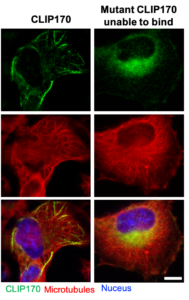
Northwestern Medicine investigators have discovered that a specialized protein associated with the microtubules of a cell helps facilitate and regulate early stages of HIV infection, according to findings published in The EMBO Journal.
Microtubules are dynamic networks located throughout cells and are responsible for performing various intracellular processes, including the transport of organelles via attachment proteins and providing shape and structure to the cell.
When viruses enter a cell, they exploit microtubules for their intracellular transport function and other processes that enable infection. But how viruses control and exploit these critical functions has remained poorly understood, according to Mojgan Naghavi, PhD, professor of Microbiology-Immunology, a member of the Robert H. Lurie Comprehensive Cancer Center of Northwestern University and senior author of the study.
Previous work by Naghavi’s laboratory found that specialized microtubule plus-end tracking proteins (+TIPs), including a specialized plus-end recognition protein called EB1, facilitate early infection of HIV. For the current study, the investigators aimed to uncover how exactly EB1 and associated +TIPs function during HIV infection.
Using super-resolution microscopy to study cells infected with fluorescently tagged HIV infected cells, the investigators found that EB1 indirectly contributed to HIV infection by delivering a +TIP and cytoplasmic linker protein called CLIP170 to the cell’s periphery, or to the cell’s inner membrane where the virus enters the cytoplasm.
Additionally, they revealed that CLIP170 bound to HIV capsids — a protein shell of the virus that encloses its genetic material — and regulated the process of capsid disassembly, ultimately promoting early infection.

Furthermore, an EB1 mimicking motif located in a conserved region of HIV capsids enabled the virus to exploit various +TIPs, including CLIP170, as the virus moved towards the nucleus, where it replicates its genome.
“Our findings reveal how HIV has evolved to mimic EB1 and co-opt unique functions of CLIP170 to control the rate of capsid disassembly during early infection. These findings also have broader implications for our understanding of evolutionary diversity across retrovirus family members and their varied replication strategies,” Naghavi said.
According to Naghavi, HIV capsids have the potential to be a promising antiretroviral therapy target and the findings could be used in developing capsid-targeting drugs.
As for next steps, the investigators are currently collaborating with a team of structural biologists to explore what HIV capsid structures are recognized by CLIP170 and whether +TIPs represent novel host cofactors that regulate certain aspects of capsid disassembly.
This work was supported by National Institutes of Health grants P01GM105536, R01AI150559 and T32AI007476-19.






